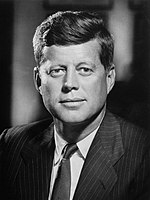
The 1988 United States presidential election was the 51st quadrennial presidential election held on Tuesday, November 8, 1988. The Republican nominee, incumbent Vice President George H. W. Bush, defeated the Democratic nominee, Governor Michael Dukakis of Massachusetts. It was the first presidential election since 1948, and the most recent to date, in which a party won more than two consecutive presidential terms. It remains the most recent election in which a candidate won over 400 electoral votes, and consequently the last landslide election of a U.S. president. Additionally, it was the last time that the Republicans won the popular vote three times in a row. Conversely, it began an ongoing streak of presidential elections that were decided by a single-digit popular vote margin. It was also the first, and only election to date, in which one of the two major presidential candidates was not of Northern European ancestry.

The 1956 United States presidential election was the 43rd quadrennial presidential election. It was held on Tuesday, November 6, 1956. President Dwight D. Eisenhower successfully ran for reelection against Adlai Stevenson II, the former Illinois governor whom he had defeated four years earlier. This election saw the sixth and most recent rematch in presidential history, and the second where the winner was the same both times. This was the last election before the term limits established by the 22nd Amendment came into effect.
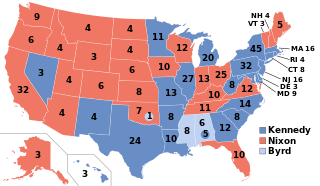
The 1960 United States presidential election was the 44th quadrennial presidential election. It was held on Tuesday, November 8, 1960. In a closely contested election, Democratic Senator John F. Kennedy defeated the incumbent Vice President Richard Nixon, the Republican nominee. This was the first election in which 50 states participated, marking the first participation of Alaska and Hawaii, and the last in which the District of Columbia did not. This made it the only presidential election where the threshold for victory was 269 electoral votes. It was also the first election in which an incumbent president was ineligible to run for a third term because of the term limits established by the 22nd Amendment.

The 1964 United States presidential election was the 45th quadrennial presidential election. It was held on Tuesday, November 3, 1964. Incumbent Democratic President Lyndon B. Johnson defeated Senator Barry Goldwater, the Republican nominee, in a landslide. Johnson was the fourth and most recent vice-president to ascend to the presidency following the death of his predecessor and to win a term in his own right. With 61.1% of the popular vote, Lyndon B. Johnson won the largest share of the popular vote for the Democratic Party in history, and the highest for any candidate since the advent of widespread popular elections in the 1820s.

The 1968 United States presidential election was the 46th quadrennial presidential election, held on Tuesday, November 5, 1968. The Republican nominee, former vice president Richard Nixon, defeated both the Democratic nominee, incumbent vice president Hubert Humphrey, and the American Independent Party nominee, former Alabama governor George Wallace.

The 1972 United States presidential election was the 47th quadrennial presidential election held on Tuesday, November 7, 1972. Incumbent Republican president Richard Nixon defeated Democratic U.S. senator George McGovern in a landslide.
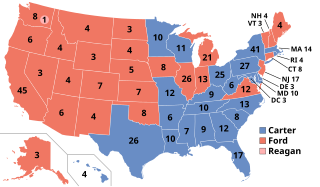
The 1976 United States presidential election was the 48th quadrennial presidential election, held on Tuesday, November 2, 1976. Democrat Jimmy Carter, former Governor of Georgia, defeated incumbent Republican president Gerald Ford in a narrow victory. Ford ascended to the presidency when Richard Nixon resigned in 1974 in the wake of the Watergate scandal, which badly damaged the Republican Party and its election prospects. Ford promised to continue Nixon's political agenda and govern as a moderate Republican, causing considerable backlash from the conservative wing of his party. This spurred former California governor Ronald Reagan to mount a significant challenge against him in the Republican primaries in which Ford narrowly prevailed. Carter was unknown at the start of the Democratic primaries, but he emerged as the front-runner after his victories in the first set of primaries. Campaigning as a political moderate in his own party and as a Washington, D.C. outsider, Carter defeated numerous opponents to clinch the Democratic nomination.
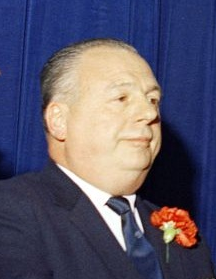
Michael Vincent DiSalle was an American attorney and politician from Ohio. A member of the Democratic Party, he served as mayor of Toledo from 1948 to 1950, and as the 60th governor of Ohio from 1959 to 1963.
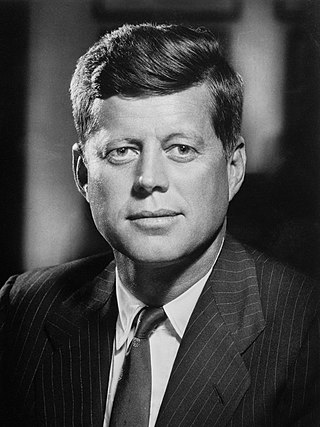
From March 8 to June 7, 1960, voters and members of the Democratic Party elected delegates to the 1960 Democratic National Convention through a series of caucuses, conventions, and primaries, partly for the purpose of nominating a candidate for President of the United States in the 1960 election. The presidential primaries were inconclusive, as several of the leading contenders did not enter them, but U.S. Senator John F. Kennedy of Massachusetts emerged as the strongest candidate and won the nomination over Lyndon B. Johnson at the convention, held from July 11 to 15 at the Los Angeles Memorial Sports Arena.

The 1960 United States presidential election in California took place on November 8, 1960 as part of the 1960 United States presidential election. State voters chose 32 representatives, or electors, to the Electoral College, who voted for president and vice president.

The 1960 United States presidential election in Pennsylvania took place on November 8, 1960 as part of the 1960 United States presidential election. Voters chose 32 representatives, or electors to the Electoral College, who voted for president and vice president.

The 1980 United States presidential election in Massachusetts took place on November 4, 1980, as part of the 1980 United States presidential election, which was held throughout all 50 states and D.C. Voters chose 14 representatives, or electors to the Electoral College, who voted for president and vice president. By an exceptionally narrow margin, Massachusetts was carried by the Republican nominee, former Governor Ronald Reagan of California, over incumbent Democratic President Jimmy Carter of Georgia. Also contesting the state was independent candidate Congressman John B. Anderson of Illinois, who won an unexpectedly solid 15%, mostly from disaffected Democratic voters.

The 1960 United States presidential election in New Jersey took place on November 8, 1960. All 50 states were part of the 1960 United States presidential election. Voters chose 16 electors to the Electoral College, which selected the president and vice president.

The 1960 United States presidential election in New Hampshire took place on November 8, 1960, as part of the 1960 United States presidential election, which was held throughout all 50 states. Voters chose four representatives, or electors to the Electoral College, who voted for president and vice president.

The 1972 United States presidential election in Florida was held on November 7, 1972, as part of the concurrent United States presidential election. Florida voters chose seventeen electors, or representatives to the Electoral College, who voted for president and vice president. Incumbent Republican President Richard Nixon won the state over the Democratic nominee, South Dakota Senator George McGovern, by a landslide margin of 44.11% and over one million votes.

The 1960 presidential campaign of John F. Kennedy, then junior United States senator from Massachusetts, was formally launched on January 2, 1960, as Senator Kennedy announced his intention to seek the Democratic Party nomination for the presidency of the United States in the 1960 presidential election.

The 1960 United States presidential election in Nebraska took place on November 8, 1960, as part of the 1960 United States presidential election. Voters chose six representatives, or electors, to the Electoral College, who voted for president and vice president.

The 1960 United States presidential election in Oregon took place on November 8, 1960, as part of the 1960 United States presidential election. Voters chose six representatives, or electors, to the Electoral College, who voted for president and vice president.



